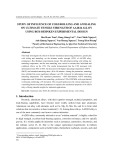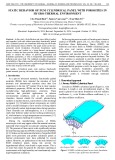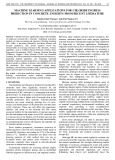
Journal of Science and Technique - Vol. 07, No. 02 (Dec. 2024)
138
EXPERIMENTAL STUDY ON THE APPLICATION OF TRC
TO ENHANCE THE LOAD-BEARING CAPACITY
OF REINFORCED CONCRETE SLABS
Thi Thu Nga Nguyen1,*, Ngoc Quang Vu1, Dinh Thanh Vu1, Trung Kien Nguyen2
1Institute of Techniques for Special Engineering, Le Quy Don Technical University
2Ministry's Office, Ministry of Construction
Abstract
To enhance load-bearing capacity and prevent structural damage, reinforced concrete elements
are often strengthened with additional layers of material. This study investigates the bonding
performance between Textile Reinforced Concrete (TRC) and reinforced concrete slabs
through four-point bending tests. The primary objective is to assess the effectiveness of surface
grooving on the old concrete to improve the adhesion between the TRC layer and the slab.
Experimental results demonstrate that TRC strengthening significantly improves both the load
capacity and mid-span deflection of the slabs. Specifically, TRC-strengthened reinforced slabs
exhibited an average 137% increase in load-bearing capacity and a 53% increase in mid-span
deflection compared to unreinforced slabs. Notably, no debonding occurred, even at failure,
confirming the reliability of the grooving technique in ensuring a strong bond. The study
concludes that TRC is an effective method for enhancing the flexural strength of reinforced
concrete slabs, while also improving safety under high loading conditions.
Keywords: Textile reinforced concrete; strengthened reinforced concrete slab; four-point bending
test; experimental study.
1. Introduction
The application of Textile Reinforced Concrete (TRC) for enhancing the load-
bearing structures of reinforced concrete constructions is an effective solution that has
been extensively studied in recent years [1, 2]. TRC is a combination of fine aggregate
concrete and high-strength fibers, such as carbon, glass, and other materials. This
combination provides TRC with superior mechanical properties, high durability, and
better abrasion resistance compared to traditional concrete. Consequently, TRC is widely
used in the construction of new structures to reduce weight, as well as in the repair and
restoration of existing structures.
TRC is also considered an optimal solution for improving the load-carrying
capacity of reinforced concrete slabs due to its significant reinforcement capabilities,
which enhance maximum load capacity, increase structural ductility, and slow down the
* Corresponding author, email: nguyennga@lqdtu.edu.vn
DOI: 10.56651/lqdtu.jst.v7.n02.890.sce

Journal of Science and Technique - ISSN 1859-0209
139
initial cracking process. Through experimental studies and numerical simulations, TRC has
proven to be highly effective in reinforcing structures subjected to bending loads [2-4].
Additionally, TRC helps mitigate the penetration of harmful environmental factors [5, 6].
A common method currently used in the practical application of bonding TRC to
old concrete slabs involves roughening or grooving the surface of the existing concrete
before applying the TRC layer [7, 8]. This method is effective in creating good surface
friction at the bond interface. It is simple, cost-effective, and suitable for real-world
construction conditions, especially in marine and island environments. However, further
experimental studies are needed to validate the effectiveness of this approach in practice.
In addition to research on TRC reinforcement for concrete elements subjected to special
loads, Le Quy Don Technical University has also conducted extensive studies on flexural
reinforcement (beams, columns, slabs) for TRC-strengthened elements. This article
presents an experimental study aimed at evaluating the impact of using TRC to enhance
the load-carrying capacity of reinforced concrete slabs employing a surface grooving
technique. The research focuses on analyzing the initial cracking load and maximum load
of the slabs to determine the effectiveness of the TRC layer, while also examining the
bonding method between the reinforcement layer and the original structure, thereby
providing insights before applying the TRC reinforcement method to reinforced concrete
slabs in practice.
2. Flexural tests of TRC-reinforced concrete slabs
2.1. Materials for slab fabrication
The normal-weight concrete B30 is used for the reinforced concrete slab structure,
while fine aggregate concrete utilizes Sikagrout 214-11, with the material characteristics
presented in Table 1.
The steel used for the slab structure belongs to group AI according to TCVN 5574-
2018, with the mechanical properties outlined in Table 2.
The textile fiber material, designated as Sigratex Grid 350, is assumed to have
similar properties for both longitudinal and transverse orientations, as shown in Table 3.
Table 1. Material parameters for different types of concrete
Concrete types
f'c
(MPa)
ft
(MPa)
Ec
(MPa)
(kg/m3)
Normal-weight concrete for
slabs (B30)
39.5
4.1
29540
0.20
2320
Fine aggregate concrete
Sikagrout 214-11
74.6
15.2
32600
0.18
2400

Journal of Science and Technique - Vol. 07, No. 02 (Dec. 2024)
140
The reinforced concrete beams (RC beams) were made from conventional B30
concrete. The concrete mix design and material properties determined from experimental
testing are shown in Table 1.
Table 2. Material parameters for steel
fy
(MPa)
Es
(MPa)
(kg/m3)
280
210000
0.3
7850
Table 3. Material parameters for textile fiber
ftu
(MPa)
Et
(MPa)
(kg/m3)
623
31940
0. 22
1740
2.2. Sample preparation process
The specimen configuration with a size of 800 mm × 400 mm × 100 mm is
illustrated in Fig. 1. The fabrication process for the unstrengthened reinforced concrete
slab is illustrated in Fig. 2 while the TRC-strengthened reinforced concrete slab is
depicted in Fig. 3 and Fig. 4. The properties of the test specimens prepared for the flexural
test are summarized in Table 4.
(a) (b)
Fig. 1. Configuration of the specimen:
(a) Unstrengthened reinforced concrete slab; (b) TRC-strengthened reinforced concrete slab.
The formwork is constructed from box steel with dimensions of 100 mm × 50 mm.
The formwork is cut and assembled according to specifications to ensure the correct
dimensions of the slab. At the joints, welding is performed to ensure the airtightness of
the formwork. After completion, the formwork is cleaned and a thin layer of oil is applied
to the inner surface to facilitate the removal process.
a150
a150
150
500
150
TRC
800
400
a150
a150
a150
400
100
800
400
400
100
30

Journal of Science and Technique - ISSN 1859-0209
141
Fig. 2. Reinforcement work, formwork, and concrete pouring of the reinforced concrete slab.
Sample fabrication process:
- Fabricate the reinforcement according to the specified design dimensions.
- Tie the reinforcement bars together to form a grid based on the design dimensions.
- Fabricate the steel formwork, clean the formwork, weld any gaps, and apply a thin
layer of release oil to the formwork.
- Pour the concrete in two layers, with each layer having a height of 50 mm.
- Use a concrete vibrator to compact the concrete thoroughly.
- After pouring the concrete, finish the surface.
- Once the concrete reaches sufficient strength at 2 days of age, remove the
formwork and proceed with the concrete curing process.
The concrete in the beams is tested for strength at 28 days, while for the strengthened
slabs, the TRC reinforcement material is applied only after the concrete has reached
sufficient strength beyond 28 days. Equipment includes grinding and grooving tools. The
grooves are 2 - 3 mm deep and spaced 5 cm apart [7]. After the first layer of mortar matrix
(1.5 mm thickness) was applied, fiber mesh was installed by pressing it into the mortar
layer, which was followed immediately by installing the top mortar layer (1.5 mm
thickness) [9].
Table 4. Characteristic of slab specimens
Specimen ID
Specimen
dimensions
(mm)
TRC strengthening
dimensions
(mm)
Number of
TRC layers
Number of
specimens
TO
800 × 400 × 100
No
1
1
TO2-1
800 × 400 × 100
Yes, 500 × 400 × 30
1
1
TO2-2
800 × 400 × 100
Yes, 500 × 400 × 30
1
1

Journal of Science and Technique - Vol. 07, No. 02 (Dec. 2024)
142
Fig. 3. Cleaning and roughening the slab surface before applying the strengthening layer.
Fig. 4. Cutting textile mesh to the slab size, formwork preparation,
and surface finishing of the strengthening layer.
2.3. Testing procedure and equipment for bending slabs
The testing setup for the slab follows a simple beam configuration (one fixed
support and one movable support), subjected to two concentrated forces denoted as P.
The locations of the applied forces and the supports are shown in Fig. 5.
(a)
(b)
Fig. 5. Bending test setup diagram for the slab:
(a) Unstrengthened reinforced concrete slab; (b) TRC-strengthened reinforced concrete slab.
100
800
100
650
325 325150
PP
800
30
325 325150
P P
75 75 65075 75





















![Bài giảng Công nghệ chế tạo: Chương 4 - Chuẩn [Tối ưu SEO]](https://cdn.tailieu.vn/images/document/thumbnail/2025/20251229/kimphuong1001/135x160/38191766998325.jpg)




